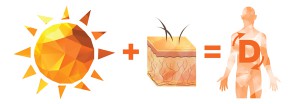
Have you ever noticed that after a good long day outdoors, maybe hiking, at the beach or even working in the yard, you feel really strong and healthy, maybe even more relaxed than after an indoor session in front of the telly or computer? Maybe a February trip to someplace sunny like Mexico or the Canary Islands has given you renewed zest for your normal tasks?
While rest and a change of scenery is never a bad thing, time outdoors and in the sunshine might have gained for you something more than rest and relaxation. If it included a little UVB irradiation, your time outdoors may have increased your serum vitamin D level. And though it’s been presumed for years, we now have proof that higher serum vitamin D3 levels correlate with a decreased incidence of certain cancers.
The Backstory
Cedric and Frank Garland first proposed a link between cancer and vitamin D 35 years ago, when they observed that colorectal cancer deaths were higher in northern latitudes and areas where there was less solar radiation (1). Since 1980, multiple epidemiologic studies have supported an inverse correlation between serum 25-hydroxyvitamin D (25(OH)D) levels and the risk of cancers of tissues including breast, colon and prostate. On April 6, McDonnell et al., a team that includes Cedric Garland, published one of the largest studies to date, examining serum vitamin D levels and cancer incidence, reported in PLOS ONE (2).
The Objective
This study’s objective was to more precisely than in previous studies, quantify the association between 25(OH)D concentrations and the risk of non-skin cancer in women 55 years and older, across a broader range of 25(OH)D concentrations than had previously been studied.
McDonnell et al. (2) used data from two previous study groups. The first of those two groups was the Lappe cohort, a double-blind, 4-year, placebo-controlled study of vitamin D and calcium supplements. Participants were recruited at random from a 9-county area of eastern Nebraska and included non-Hispanic white women age 55 years and older with no known cancer at start of the study and no cancer in the preceding 10 years.
The Lappe study included three different supplementation groups, including those that took: 1) calcium (1,400 mg/day calcium citrate or 1,500mg/day calcium carbonate) plus vitamin D placebo; 2) calcium (1,400 mg/day calcium citrate or 1,500mg/day calcium carbonate) plus 1,000 IU/day of vitamin D3, and; 3) a control group that took calcium and vitamin D placebos (20% of the total group was placebo).
Lappe study members reported on health status and vitamin intake at 6-month intervals. If a cancer diagnosis was reported, records were examined to confirm and ascertain diagnosis date. Serum concentrations were measured at baseline and annually using radioimmunoassay.
A second group that was included in the PLOS ONE study, the GrassrootsHealth cohort, was a prospective, population-based study that allowed voluntary participants to reach and sustain a serum 25(OH)D concentration of their choice. Participants were recruited at a GrassrootsHealth seminar or online and there were no exclusion criteria for this study. Participants completed an online health questionnaire submitted a home blood spot 25(OH)D test.
McDonnell et al. (2) used these two existing studies to achieve a broader range of 25(OH)D serum levels across which to examine cancer incidence. The Lappe study (n = 1,669 members) had a median 25(OH)D of 30ng/ml (range of 25–37), while the GrassrootsHealth participants (n = 1,135) had a median 25(OH)D of 48ng/ml (range of 39–61).
The PLOS ONE study ran from January 2009 to December 2014. Enrollees completed health questionaires and home blood spot test kits at 6 month intervals. They submitted reports on cancer diagnosis date and type, average daily calcium supplement intake, smoking status, and height and weight information for calculation of body mass index (BMI). Serum 25(OH)D concentrations were determined by blood spot analysis using liquid chromatograph-mass spectrometry (LC-MS) performed at one of two laboratories; both laboratories were validated against LC-MS/MS consensus group reporting (2).
The Results
The PLOS ONE study had an n = 2,304, with a median follow-up length of 3.9 years. There were some cancer diagnoses in this group; the most common cancer was breast cancer. Details of the statistical analyses done for this study are available in the article (2).

Cancer incidence rates were calculated for both baseline and mean 25(OH)D, and overall cancer incidence rates were lower when 25(OH)D concentrations were higher. There was a 77% lower incidence cancer rate for >40ng/ml vs. <20ng/ml, with a continued decline in cancer rates as serum 25(OH)D levels increased.
Another interesting piece of data from this study was the authors’ note that cancer-free survival over time was also better for study participants with 25(OH)D levels >40ng/ml; 98% of that group was cancer-free at 4 years. It is important to note that skin cancer was excluded from this study.
Another Study, Different Results
McDonnell et al. noted that the Womens Health Initiative (WHI), a well-known, randomized trial, which did not find an association between vitamin D and colorectal or breast cancer incidence, used vitamin D doses of 400IU/day. McDonnell et al. comment that this intake amount probably did not raise basal serum concentrations sufficiently to influence health outcomes. In addition, it’s known that the WHI study had a compliance rate for supplement intake in only the 50% range (2).
New Vitamin D Information
In vitamin D research there are some exciting, recent developments, newly-identified, naturally-occurring vitamin D3 metabolites found in human epidermis and serum. These compounds are products of CYO11A1-mediated metabolism of vitamin D3 and have shown anti-proliferative, anti-inflammatory effects equal to those of 1,25(OH)D3 (3–5). These studies show that there are many active vitamin D metabolites that many contribute to solar UVB ray affects on serum 25(OH)D3 concentrations. The influence of these newly identified compounds has yet to be determined in terms of their influence on cancer incidence.
Recommendations for Vitamin D Supplementation
If you are a vitamin D enthusiast, you might wonder about the bottom line in terms of vitamin D supplements, and/or serum 25(OH)D concentrations. Pramyothin and Holick (6) summarized recommendations from the 2011 US Institute of Medicine report (on vitamin D) plus the recent guideline from the US Endocrine Society with emphasis on treating and preventing vitamin D deficiency. The US Institute of Medicine said that serum 25-hydroxyvitamin D [25(OH)D] of 20ng/ml or more will cover the requirements of 97.5% of the population. The US Endocrine Society’s Clinical Practice Guideline was to maintain 25(OH)D above the optimal level of 30ng/ml. Patients with inflammatory bowel disease (active and inactive) and those with gastric bypass malabsorb vitamin D and need more vitamin D to sustain their vitamin D status.
Of course your best source of guidance will come from your personal physician/healthcare provider as to what your serum 25(OH)D levels are, and if you should take a supplement.
For many of us, more time outdoors in the sunshine will achieve increased serum vitamin D levels and, possibly, improved health.
References
- Garland, C.F. and Garland F.C. (1980) Do sunlight and vitamin D reduce the likelihood of colon cancer? Int. J. Epidemiol. 9(3), 227–31.
- McDonnell, S.L. et al. (2016) Serum 25-Hydroxyvitamin D Concentrations ≥40 ng/ml Are Associated with >65% Lower Cancer Risk: Pooled Analysis of Randomized Trial and Prospective Cohort Study. PLOS ONE 11(4):e0152441.
- Slominski, A.T. et al. (2012) In vivo evidence for a novel pathway of vitamin D₃ metabolism initiated by P450scc and modified by CYP27B1. FASEB J. 26(9):3901–15.
- Slominski, A.T. et al. (2014) The role of CYP11A1 in the production of vitamin D metabolites and their role in the regulation of epidermal functions. J. Steroid Biochem. Mol. Biol. 144 Pt A:28–39.
- Slominski, A.T. et al. (2015) Detection of novel CYP11A1-derived secosteroids in the human epidermis and serum and pig adrenal gland. Sci. Rep. 5:14875.
- Pramyothin P., Holick M.F. (2012) Vitamin D supplementation: guidelines and evidence for subclinical deficiency. Curr Opin Gastroenterol. 28(2):139–50.
Kari Kenefick
Latest posts by Kari Kenefick (see all)
- Fluorescent Ligands in Biological Research: Where We’ve Been, Where We’re Headed - June 27, 2024
- Cell-Based Target Engagement and Functional Assays for NLRP3 Inhibitor Profiling Help Identify Successes and Failures - January 25, 2024
- Illuminating the Brain with a New Bioluminescence Imaging Substrate - April 13, 2023
